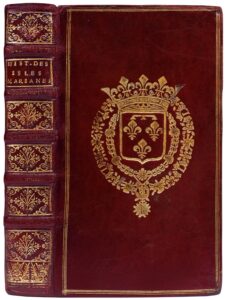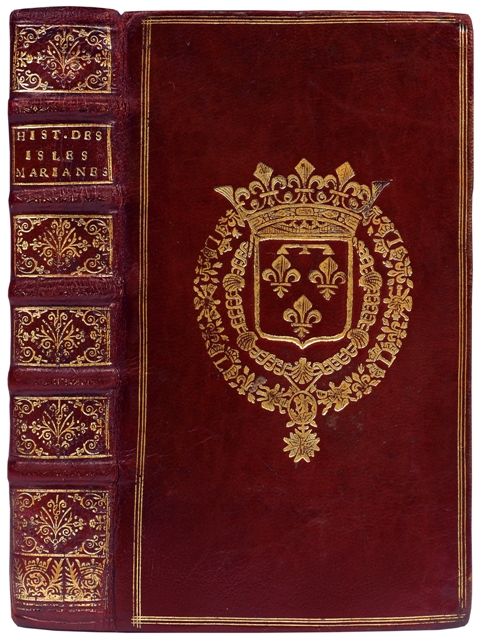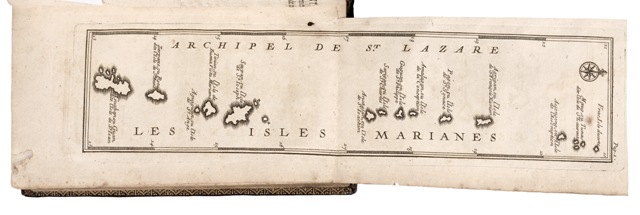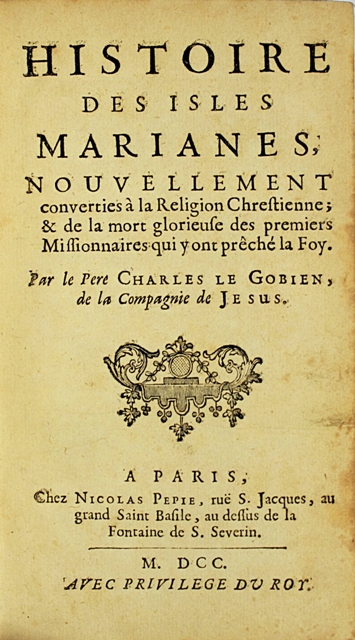Paris, Nicolas Pepie, 1700.
12mo [159 x 87 mm] of (12) ll. including the half-title, the title, the epistle, the advertisement and the protestation (recto) and permission (verso) leaf; 433 pp., 2 folding plates (the Mariana Islands and the Guam island), light browning in the leaves, complete with the permission leaf generally missing, without the errata leaf which is missing in the other Royal family copies (see below). Full red morocco, triple gilt fillet on the covers, coat of arms at the center of the covers, spine ribbed and richly decorated with small gilt tools, border with the crowned dauphin at the back of the spine, inner border, gilt over marbled edges. Contemporary binding attributable to Luc-Antoine Boyet.
“Rare first edition”, mentions Chadenat.
“Rare volume” mentions Brunet (Supp. II, 821).
It is illustrated with two folding maps: the first one entitled “Archipel de St Lazare. Les Isles Marianes”; the second one “L’Isle de Guahan ou Guan, dite l’Isle de St Jean”.
Charles Le Gobien (1653-1708), from Saint-Malo, joined in 1671 the Society of Jesus. He taught in Tours, then in Paris, and became in 1706 procurator of the China missions.
He published several books about the Far East that had considerable resounding in Louis XIV’s court and contributed to arouse the attention of the political and diplomatic elite about this mysterious East. The Mariana Islands, located in Oceania, were discovered by Magellan in 1521. The first missionaries arrived in the 17th century under Philip IV’s reign.
Charles le Gobien depicts joyfully the habits, customs and the everyday life of the natives. The matriarchy reigning on the island deeply surprises him and he gives us there some of his best pages. Most of the volume is dedicated to the history of the relations between the Europeans and the natives and especially to the difficulties met by the missionaries in their conversion policy.
A precious copy bound in contemporary red morocco, with the arms of Philip of France, Duke of Orléans, brother of King Louis XIV, father of the Régent.
Philip of France (1640-1701), also mentioned as Philip, Duke of Orléans or Monsieur, brother of Louis XIV, second son of the King Louis XII of France and Navarre, and of his wife the infant Anne of Austria, was born two years after his brother. First entitled Duke of Anjou at his birth, he is the presumptive heir to the throne (1643-1661) until the birth of the great dauphin. He will be nicknamed the small Monsieur to distinguish him from his uncle Gaston, Duke of Orléans, who is then nicknamed the great Monsieur. At Gaston’s death and at the accession of Louis XIV, Philip will fully wear his title of Monsieur, brother of the King, and will get as a privilege the duchy of Orléans.
(OHR, plate 2562, arm n°1 and 2 with variations mentioned by Olivier about the crown, the collar and the charges of the blazon).
See less information



